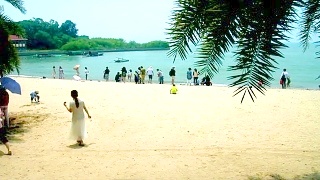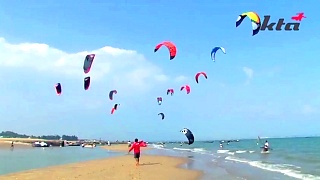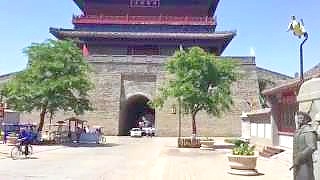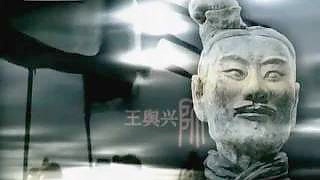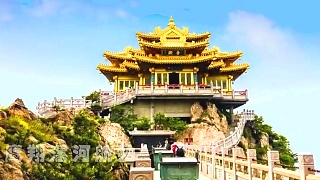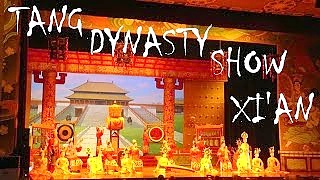With Andy see the World ...
[640],shadow=true,start=,stop=Visitor Guide to ShanHaiGuan
Overview
ShanHaiGuan, located in QinHuangDao City, HeBei Province, is a renowned historical site known as the "First Pass Under Heaven." It is one of the most well-preserved and strategically important passes of the Great Wall of China, offering visitors a fascinating glimpse into China's ancient military history and stunning coastal scenery.
Getting There
By Air: The nearest airport is QinHuangDao Beidaihe Airport (BPE), located about 20 kilometers from ShanHaiGuan. From the airport, you can take a taxi or a shuttle bus to ShanHaiGuan.
By Train: ShanHaiGuan Railway Station is well-connected with major cities like BeiJing, TianJin, and Shenyang. High-speed trains make it convenient to reach ShanHaiGuan from these cities.
By Bus: Long-distance buses are available from nearby cities, including QinHuangDao and TianJin. The main bus station in ShanHaiGuan is ShanHaiGuan Long-Distance Bus Station.
Getting Around
- Walking: The historic area of ShanHaiGuan is best explored on foot, allowing you to fully appreciate the ancient architecture and fortifications.
- Biking: Renting a bicycle is a great way to explore the surrounding areas and nearby attractions at your own pace.
- Local Transport: Taxis and local buses are available for traveling to and from different parts of ShanHaiGuan and QinHuangDao.
Main Attractions
First Pass Under Heaven (Zhenyuan Tower)
This iconic gate is the easternmost point of the Great Wall and marks the starting point of the ancient defense line. The tower offers panoramic views of the surrounding area and the Great Wall stretching towards the mountains and the sea.
Old Dragon's Head (Laolongtou)
Located where the Great Wall meets the Bohai Sea, the Old Dragon's Head is a dramatic and picturesque site. The fortifications extend into the sea, resembling a dragon drinking water. It's a unique and breathtaking part of the Great Wall.
ShanHaiGuan Great Wall Museum
The museum provides a comprehensive overview of the history, construction, and significance of the Great Wall. Exhibits include artifacts, models, and interactive displays that bring the history of this monumental structure to life.
Jiumenkou Great Wall
This section of the Great Wall is unique for its series of nine gates and the river that flows beneath it. The Jiumenkou Great Wall is a UNESCO World Heritage Site and offers a fascinating look at ancient military engineering.
Wang Family Courtyard
This well-preserved traditional courtyard residence offers a glimpse into the lifestyle of a wealthy family during the Ming and Qing Dynasties. The courtyard is beautifully decorated with intricate carvings and traditional furnishings.
Local Cuisine
ShanHaiGuan's cuisine is influenced by its coastal location and northern Chinese culinary traditions. Here are some must-try dishes:
- Seafood: Fresh seafood from the Bohai Sea, including fish, shrimp, and crab, is a highlight of local dining.
- QinHuangDao Dumplings: These dumplings are known for their thin skins and generous fillings, often served with a dipping sauce.
- Jiaozi (Dumplings): A variety of steamed or boiled dumplings filled with meat, vegetables, or seafood.
- Local Snacks: Try street food such as fried dough twists, roasted sweet potatoes, and various grilled skewers.
Shopping
- Local Handicrafts: ShanHaiGuan is known for its traditional handicrafts, including paper-cutting, clay figurines, and embroidery. These items make for unique souvenirs.
- Antique Markets: Explore local antique markets for historical artifacts, vintage items, and collectibles.
- Seafood Markets: Purchase fresh or dried seafood to take home or enjoy while you're in the area.
Accommodation
- Luxury Hotels: For a high-end stay, consider hotels like the Shangri-La Hotel QinHuangDao or the Sheraton QinHuangDao Beidaihe Hotel, both offering excellent amenities and service.
- Mid-Range Hotels: Options such as the Best Western Junyu Grand Hotel and QinHuangDao Grand Hotel provide comfortable accommodations at reasonable prices.
- Budget Hotels: For budget travelers, hostels and budget hotels like the ShanHaiGuan Youth Hostel offer affordable and convenient lodging.
Tips for Visitors
- Best Time to Visit: The best times to visit ShanHaiGuan are spring (April to June) and autumn (September to November) when the weather is mild and pleasant.
- Clothing: Wear comfortable walking shoes and dress in layers to accommodate changing temperatures. An umbrella or raincoat is useful during the rainy season.
- Respect Local Customs: Be respectful of local customs and traditions. Dress modestly and be mindful of local etiquette, especially when visiting historical and cultural sites.
- Language: While Mandarin is widely spoken, learning a few basic phrases or using a translation app can be very helpful.
- Plan Your Visit: ShanHaiGuan is best explored at a leisurely pace. Take your time to wander through the historical sites, visit local shops, and enjoy the tranquil atmosphere.
Conclusion
ShanHaiGuan, with its rich history, strategic importance, and stunning coastal scenery, offers a unique and memorable travel experience. Whether you're exploring ancient fortifications, savoring fresh seafood, or strolling along the Great Wall, ShanHaiGuan provides an unforgettable experience. Plan your visit carefully to make the most of your trip to this fascinating destination in HeBei Province.
The Great Wall of China is one of the most iconic and awe-inspiring attractions in the world, drawing millions of tourists each year. Here's a guide for tourists visiting the Great Wall:
History and Significance:
Historical Significance: The Great Wall of China is a series of fortifications built over centuries to protect China from invasions by nomadic tribes from the north. Its construction began as early as the 7th century BC and continued through different dynasties, with the most famous sections built during the Ming Dynasty (13681644 AD).
Length and Structure: Stretching over 13,000 miles (21,196 kilometers), the Great Wall is not a continuous wall but a series of walls, trenches, and natural barriers, including mountains and rivers. Its main purpose was to provide defense and control trade routes along the northern border of China.
Visiting the Great Wall:
Sections to Visit: While the entire Great Wall is massive, certain sections are more accessible and popular among tourists. The most visited sections include Badaling, Mutianyu, Jinshanling, and Simatai. Each section offers unique features and experiences.
Badaling: This section is the closest to Beijing and is one of the most well-preserved and accessible sections of the Great Wall. It can be crowded, especially during peak tourist seasons.
Mutianyu: Located about 1.5 to 2 hours' drive from Beijing, Mutianyu offers a less crowded but equally impressive experience. It features restored sections as well as more rugged and original parts.
Jinshanling and Simatai: These sections are farther from Beijing but are known for their scenic beauty and relatively fewer crowds. They offer a more authentic and adventurous hiking experience.
Tips for Tourists:
Best Time to Visit: The Great Wall can be visited year-round, but the best times are spring (April to June) and autumn (September to November) when the weather is pleasant, and the scenery is beautiful.
Avoiding Crowds: To avoid crowds, consider visiting the Great Wall early in the morning or during weekdays. Badaling tends to be busiest, so opting for less-visited sections like Jinshanling or Simatai can provide a more peaceful experience.
Wear Comfortable Clothing: The Great Wall involves a fair amount of walking and climbing stairs, so wear comfortable shoes and clothing suitable for hiking.
Stay Hydrated and Sun-Protected: Bring plenty of water, sunscreen, and a hat, especially during hot summer months, as there may be limited shade on the Wall.
Respect the Environment: Help preserve the Great Wall for future generations by refraining from littering, defacing, or damaging the structure.
Cultural Insights:
Learn about the History: Take the time to learn about the history and significance of the Great Wall through signage, guidebooks, or guided tours.
Capture Memories: Don't forget to bring a camera or smartphone to capture the breathtaking views and memories of your visit.
Interact with Locals: Engage with local vendors, tour guides, or fellow travelers to gain insights into Chinese culture and customs related to the Great Wall.
Visiting the Great Wall of China is a once-in-a-lifetime experience that offers not only breathtaking views and photo opportunities but also a deeper appreciation for one of the world's most remarkable architectural achievements.
 ShanHaiGuan (Mountain Sea Pass) – where the Great Wall of China meets the sea
ShanHaiGuan (Mountain Sea Pass) – where the Great Wall of China meets the sea


